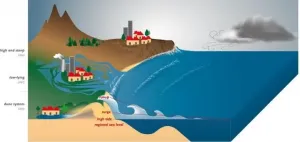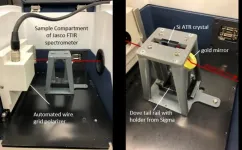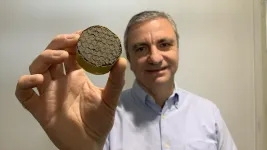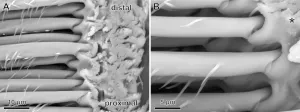(Press-News.org) URBANA, Ill. - For the most accurate accounting of a product's environmental impact, scientists look at the product's entire life cycle, from cradle to grave. It's a grand calculation known as a life cycle assessment (LCA), and greenhouse gas emissions are a key component.
For corn ethanol, most greenhouse gas emissions can be mapped to the fuel's production, transportation, and combustion, but a large portion of the greenhouse gas calculation can be traced right back to the farm. Because of privacy concerns, however, scientists can't access individual farm management decisions such as fertilizer type and rate.
Nitrogen fertilizer data are an important piece of the calculation because a portion of these fertilizers wind up in the atmosphere in the form of nitrous oxide, a highly potent greenhouse gas. Corn nitrogen fertilizer data are publicly available at the national and state levels, but scientists argue this level of resolution masks what's really being applied on farms across the country and could lead to inaccurate LCAs for corn ethanol.
In a new study from the University of Illinois and the U.S. Department of Energy's Argonne National Laboratory, researchers developed the first county-level nitrogen application datasets for corn, dramatically improving the accuracy of greenhouse gas calculations for the crop.
"Having good data is really important to foster both a shared discussion and greater confidence in LCAs. We've seen some abuses of life cycle analysis using really crude numbers, downscaling big averages that can really vary a lot. So even though the county level still isn't as precise as we would like, it's a big accomplishment to get to that scale," says Michelle Wander, professor in the Department of Natural Resources and Environmental Sciences at Illinois and co-author on the study.
Hoyoung Kwon, principal environmental scientist in the Systems Assessments Center at Argonne and co-author on the study, says the protocol and findings will help the agricultural and bioeconomy community better understand the impacts of high-resolution nitrogen fertilizer data on corn-based biofuel LCAs.
"Nitrous oxide makes up about half of the total greenhouse gases associated with corn farming," Kwon says. "Now we can differentiate nitrous oxide emission associated with corn farming on the county level, and can show how much these emissions vary with location and farming practice."
Yushu Xia, who led the analysis and recently finished her doctoral program with Wander, used two approaches to determine county-level nitrogen fertilizer and manure usage.
The first, which Xia calls the top-down approach, was a bit like putting a puzzle together using different-sized pieces. At the county level, she found data for nitrogen fertilizer and manure inputs, but the numbers were aggregated across all crops, not corn specifically. The state level dataset included fertilized area in corn, so it was a matter of matching county with state. The state dataset also included nitrogen inputs, but aggregated them across fertilizer types. Data validation, or double-checking state and country information, therefore became another puzzle.
"For the top-down approach, we used data derived from fertilizer sales, information compiled by the Association of American Plant Food Control Officials. So we assume these numbers are relatively accurate; somebody actually bought that nitrogen. Yushu went through painstaking effort, basically using that crop data layer like a jigsaw puzzle to figure out how much corn is where and in what rotation over time. And then also for the manure: How many animals are there? Where are they? What kind of animal waste and how much? It's literally a budgeting effort to try to find out what's reasonable and true," Wander says.
Xia's second approach took corn yield, crop rotations, and soil properties from the county level and estimated nitrogen inputs based on the amount of nitrogen it would take to achieve that yield. Comparing the results of the two approaches told Xia farmers are applying nitrogen in excess of what's needed.
"Nationally, the weighted averages of corn nitrogen inputs based on corn planted area exceeded nitrogen needs by 60 kilograms per hectare, with a nitrogen surplus found in 80% of all U.S. corn producing counties," Xia says.
Excess application was most pronounced in the Midwest, followed by the Northern Plains. The Southeast and Northwest had comparatively low nitrogen application rates and surplus levels. Western states were more variable overall.
Xia says the technique can be useful beyond nitrous oxide emissions estimations.
"Our approach can also be used to estimate nitrogen leaching, ammonia emissions, other greenhouse gas emissions, or the water and carbon footprint. These data improvements can really help to create and utilize better ecosystem models and life cycle analysis."
Kwon indicates the new approach could potentially be used by policymakers at the national level.
"The EPA's national greenhouse gas inventory report currently uses state-level nitrogen fertilizer data to generate national estimates of nitrous oxide emissions from fertilizer. If they apply these high-resolution county-level data, they can refine those numbers on a national scale."
The results could also help farmers make more informed management decisions.
"Fertilizer prices are sky high right now, so since our results suggest some farmers are over-applying up to a third of their nitrogen, they could probably back off a bit and save some money," Wander says.
INFORMATION:
The article, "Developing county-level data of nitrogen fertilizer and manure inputs for corn production in the United States," is published in the Journal of Cleaner Production [DOI: 10.1016/j.jclepro.2021.126957]. Funding was provided by the U.S. Department of Energy and USDA's National Institute of Food and Agriculture.
The Department of Natural Resources and Environmental Sciences is in the College of Agricultural, Consumer and Environmental Sciences at the University of Illinois.
A decade-long study of the most common forearm fracture in older adults revealed that personalized medicine catering to a patient's individual needs and environment, not age or X-rays, should guide treatment options.
Led by a Michigan Medicine physician, the research team examined treatment outcomes over two years for patients who fractured their distal radius, the larger of two bones in the forearm. They found no one-size-fits all method for treating the fracture, which more than 85,000 Medicare beneficiaries sustain annually.
"Traditionally, surgeons look at these broken bones on X-rays, and they have to assess various ways of fixing it based off fracture anatomy and patient age," said Kevin Chung, M.D., study lead and Charles B. G. De ...
By combining satellite data and digital models, the researchers have shown that coastal overtopping, and consequently the risk of flooding, is set to further accelerate over the 21st century, by up to 50-fold under a high emission global warming scenario, especially in the tropics. This increase is principally caused by a combination of sea level rise and ocean waves.
Low-lying coastal regions host nearly 10% of the world's population. In addition to ongoing erosion and rising sea levels, these areas and their unique ecosystems are facing destructive hazards, including episodic flooding due to overtopping of natural/artificial protection, as in the case of Hurricane Katrina, ...
Scientists from the Walter Reed Army Institute of Research and Naval Medical Research Center partnered with researchers at the University of Pennsylvania and Acuitas Therapeutics to develop a novel vaccine based on mRNA technology that protects against malaria in animal models, publishing their findings in npj Vaccines.
In 2019, there were an estimated 229 million cases of malaria and 409,000 deaths globally, creating an extraordinary cost in terms of human morbidity, mortality, economic burden, and regional social stability. Worldwide, Plasmodium falciparum is the parasite species which ...
A staged alert system, designed by scientists and public health officials to guide local policies, helped one city prevent hospital surges and long lockdowns, according to new research published in the journal Nature Communications.
In a new study led by The University of Texas at Austin COVID-19 Modeling Consortium in collaboration with Northwestern University, researchers describe the system that has guided COVID-19 policies in Austin, Texas, for more than a year, helping to safeguard the health care system and avoid costly measures. It tracks the number of new daily COVID-19 hospital admissions and triggers changes in guidance when admissions cross specific threshold values. While using this staged alert system, the Austin metropolitan area has sustained the ...
A hydrogel that forms a barrier to keep heart tissue from adhering to surrounding tissue after surgery was developed and successfully tested in rodents by a team of University of California San Diego researchers. The team of engineers, scientists and physicians also conducted a pilot study on porcine hearts, with promising results.
They describe their work in the June 18, 2021 issue of Nature Communications.
In rats, the hydrogel prevented the formation of adhesions altogether. In a small pilot study, porcine hearts treated with the hydrogel experienced less severe adhesions that were easier to remove. In addition, the hydrogel did not appear to cause chronic inflammation.
Adhesions--organ tissue sticking to surrounding tissue--are a relatively ...
"Any problem can be solved with a little ingenuity". While they may not be the originators of this quote, recent work from researchers at Osaka Prefecture University into understanding the molecular orientation of hybrid thin-film material is a concrete example of its central message. "We wanted everyone to have access to this knowledge," states research lead Professor Masahide Takahashi of the OPU Graduate School of Engineering. Using laboratory-grade equipment with 3D printable optical setups, his research group has established an easy, versatile, yet highly sensitive approach ...
Sophia Antipolis - 18 June 2021: A small feasibility study has suggested that tai chi has the potential to reduce depression, anxiety and stress plus improve sleep in people who have had a stroke. The research is presented today at EuroHeartCare - ACNAP Congress 2021, an online scientific congress of the European Society of Cardiology (ESC).1
Depression occurs in approximately one-third of stroke survivors and is linked with greater disability and mortality rates.2,3 Individuals with post-stroke depression frequently also report anxiety, stress, and poor sleep.4-6
Tai chi focuses on releasing tension in the body, incorporating mindfulness and imagery into movement, increasing awareness and efficiency of breathing, and promoting overall relaxation of body and mind.
"Mind-body ...
While postpartum depression in new mothers is well recognized and known to increase if the newborn requires intensive care, depression in new fathers has not received much attention. A large study, published in the journal Pediatrics, found that both parents with a baby in the NICU are at risk, with depression symptoms identified in 33 percent of mothers and 17 percent of fathers. Strikingly, the probability of reporting depression symptoms declined significantly for mothers but not for fathers after the baby came home.
"Our findings point to the need for increased attention to the mental health of new fathers, during their baby's NICU stay and after discharge," said lead author Craig F. ...
An incredibly light new material that can reduce aircraft engine noise and improve passenger comfort has been developed at the University of Bath.
The graphene oxide-polyvinyl alcohol aerogel weighs just 2.1kg per cubic metre, making it the lightest sound insulation ever manufactured. It could be used as insulation within aircraft engines to reduce noise by up to 16 decibels - reducing the 105-decibel roar of a jet engine taking off to a sound closer to that of a hair-dryer.
The aerogel's meringue-like structure makes it extremely light, meaning it could act as an insulator within aircraft engine nacelles, with almost no increase ...
Just how do spiders walk straight up -- and even upside-down across -- so many different types of surfaces? Answering this question could open up new opportunities for creating powerful, yet reversible, bioinspired adhesives. Scientists have been working to better understand spider feet for the past several decades. Now, a new study in END ...






